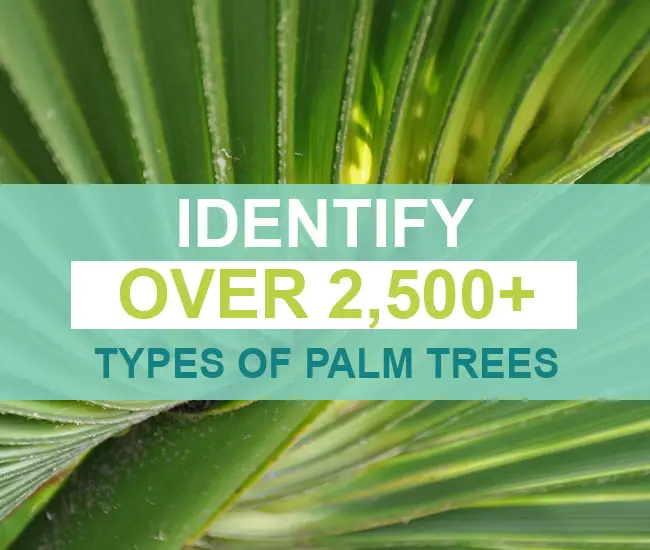
With over 2,500+ species, it can be challenging to identify a palm tree. So, it is unsurprising that I get many emails asking for help with palm tree identification. Since different palms require different care, it is important to know their species.
Some palms like a lot of sun and warm climate, others prefer shade and can tolerate cold temperatures. In my opinion, cold tolerance is one of the most important characteristics of the palm, since it can make a huge difference in the location where it can be grown.
When buying a palm from a home improvement store or a garden center, keep in mind, that it can be mislabeled. That is one of the reasons I always recommend buying palms from a reputable nursery.
In this post, I want to highlight key characteristics that I use to distinguish palm species. Palms can be separated by leaf shape, trunk type, flower, fruits, and size.
How to Identify a Palm Tree Step-By-Step
Step 1: Leaf Type. When I am trying to identify a palm tree, I start with the leaves. Are the leaves fan-shaped or feather-shaped? Oher shape?
Step 2: Crownshaft. Does the palm has a crownshaft (which is elongated leaf base)? What color is the crownshaft?
Step 3: Leaf Stems. Do leaf stems have teeth? Are they smooth? What color?
Step 4: Trunk Type. How many trunks? Is the trunk smooth or covered with old leaf bases? Does it have a unique texture? Is it swollen?
Step 5: Fruits and Flowers. What color are the flowers? What type of fruits it’s producing? What is the fruit color?
Step 6: Palm Size. How tall is the palm?
Palm Identification By Leaf Type
Palm leaves consist of three parts: leaf base, leaf stem, and leaf itself. The leaf base is the part where the stem attaches to the trunk. On many palms, the leaf base remains on the trunk even after the frond drops off creating a distinctive pattern.
But the easiest place to start is the leaves. Palms can be categorized into three main leaf types which are: pinnate (feather-shaped), palmate (fan-shaped), and entire (simple).
Most of the palms fall into pinnate or palmate categories. simple leaf type is rare. Another two subcategories that are worth mentioning are costapalmate and bi-pinnate.
- Pinnate Leaf (Feather-shaped)
- Palmate Leaf (Fan-shaped)
- Costapalmate Leaf
- Bi-Pinnate Leaf
- Entire Leaf (Simple)
1. Pinnate Leaf (Feather-shaped)
Pinnate (Feather-like) fronds consist of separate long leaflets that grow from the central stalk. Some of the popular palm trees with pinnate leaves are Buccaneer Palm, Majesty Palm, Queen Palm, and Sylvester Date Palm.
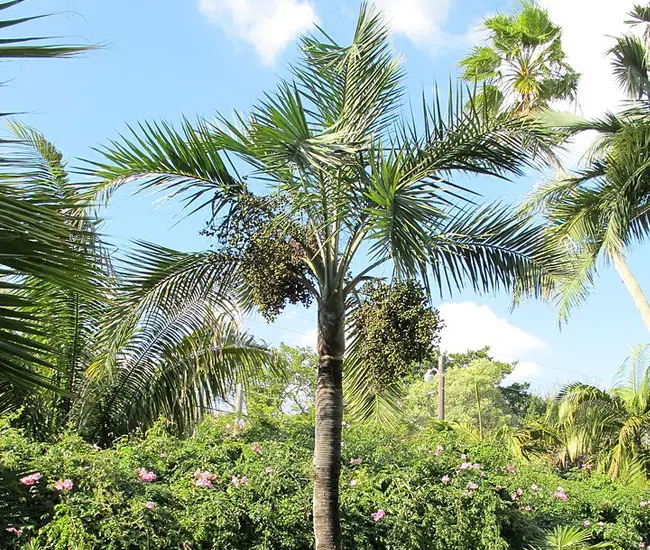
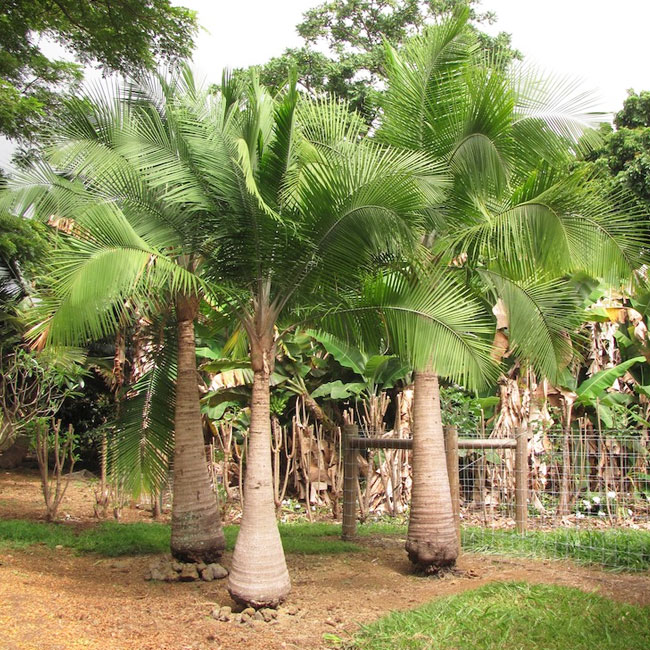
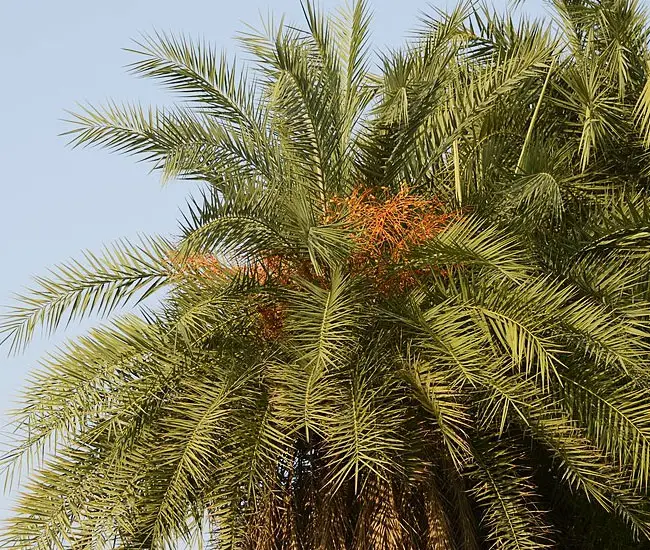
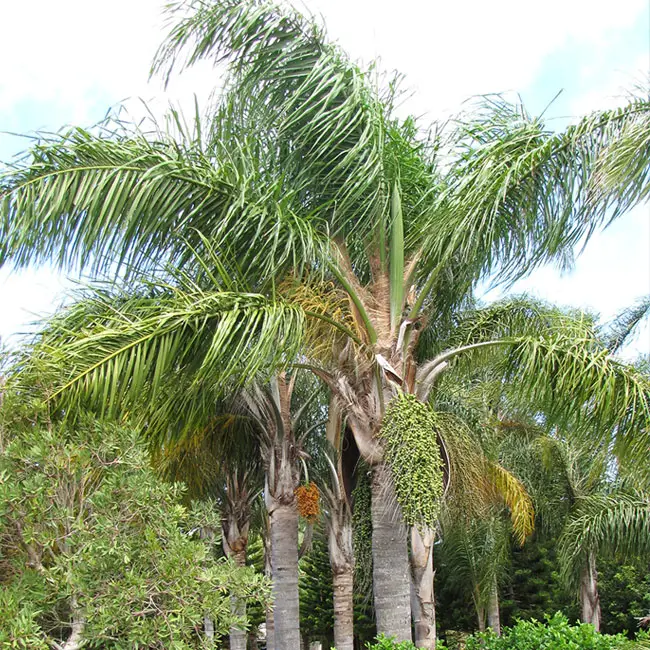
2. Palmate Leaf (Fan-shaped)
Fan-shaped fronds radiate from a central point along the stem like fingers on your hand. Some of the popular palms with fan-shaped leaves are the Everglades Palm, European Fan Palm, Windmill Palm, and Ruffled Fan Palm.
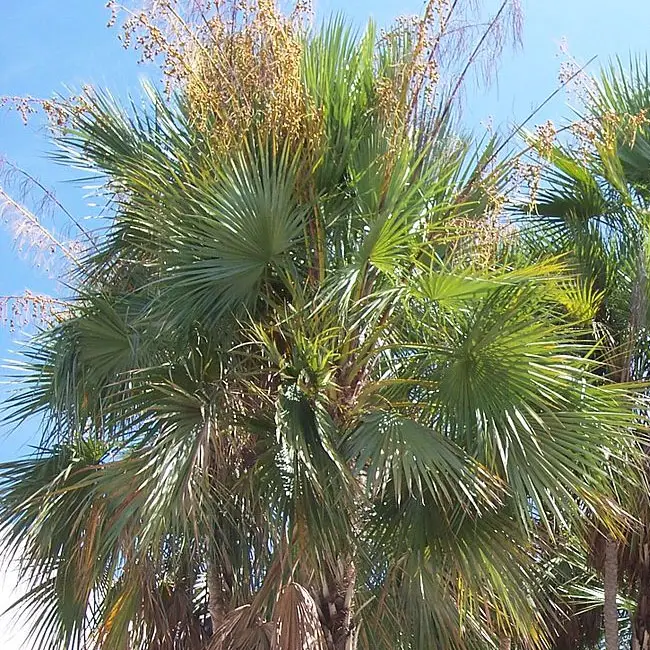
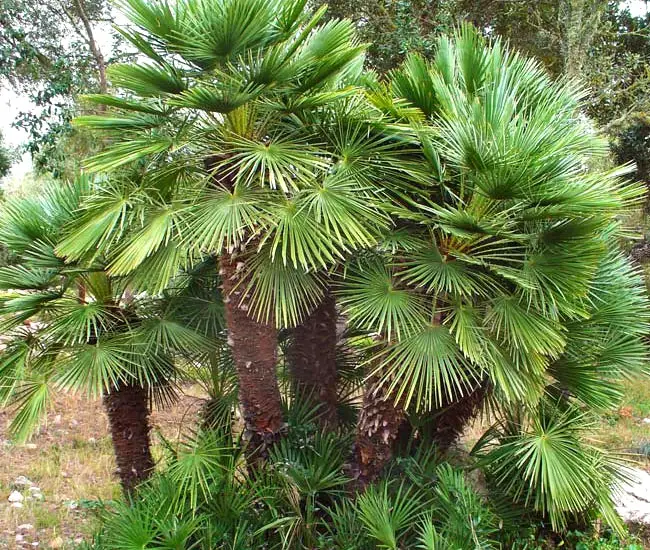
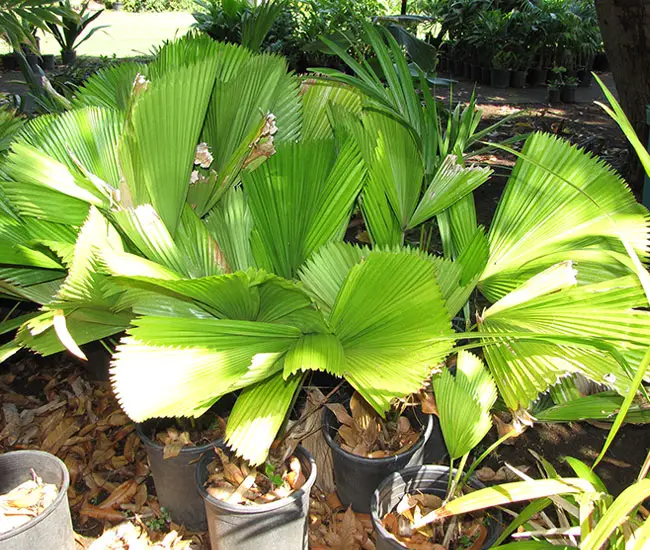
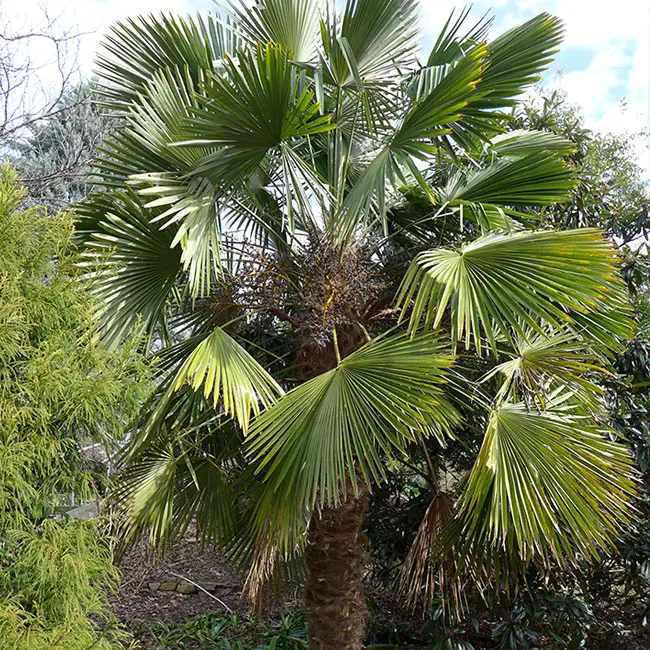
3. Costapalmate Leaf
While the Costapalmate palms are a subcategory of the fan-shaped palm, they look like a cross between palmate and pinnate. They have a short midrib instead of a center point from which the leaf segments radiate.
They are often twisted and folded sharply along the tip of the leaf stem. Some of the palms with costapalmate leaf types are Blue Latan Palm, Red Latan Palm, Fiji Fan Palm, and Chinese Fan Palm.
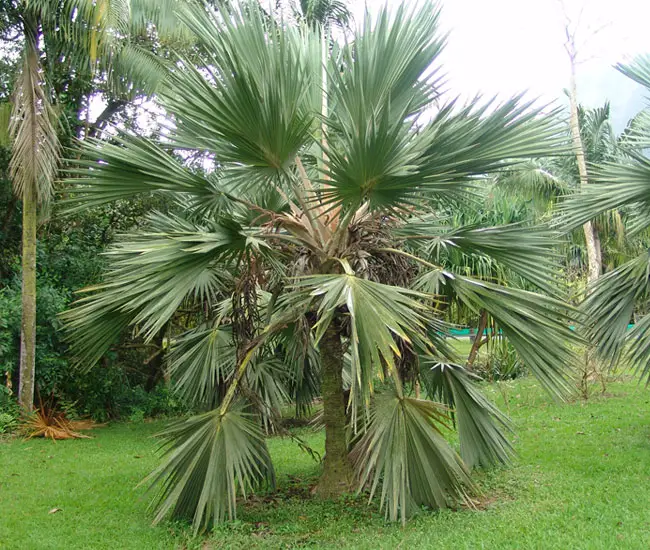
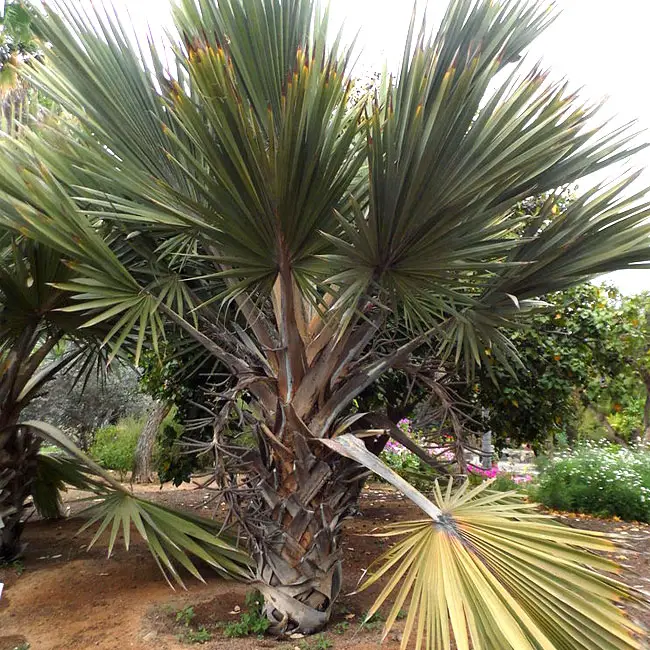
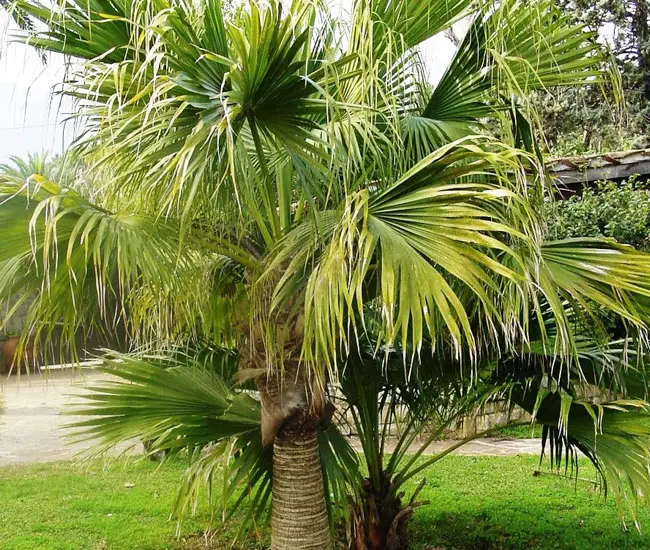
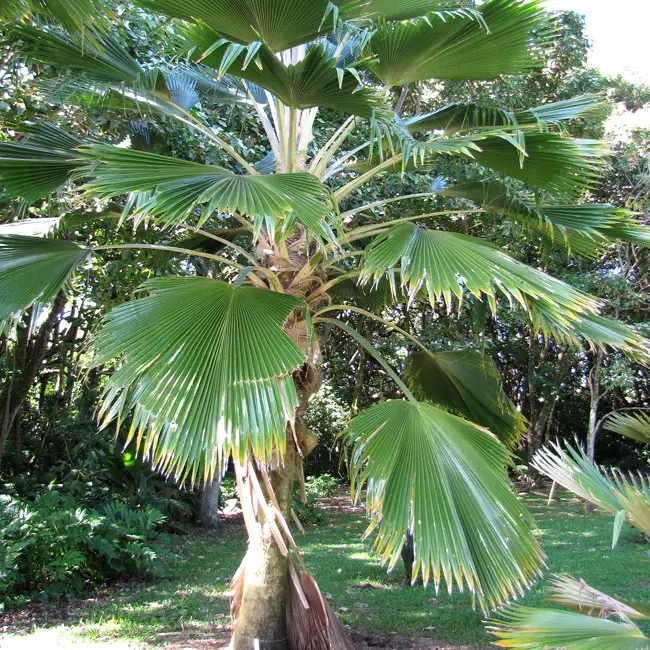
4. Bi-Pinnate Leaf
These palms have a secondary leaf stem that is attached to the primary one, and the leaflets are connected to the secondary stem at regular intervals. This type of palm is very rare occurring only in a single type of palm called the Fishtail Palm (Caryota).
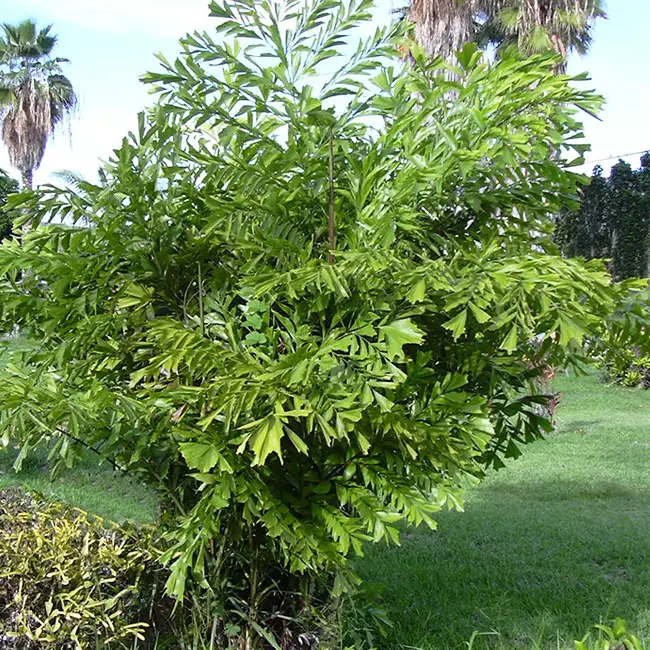
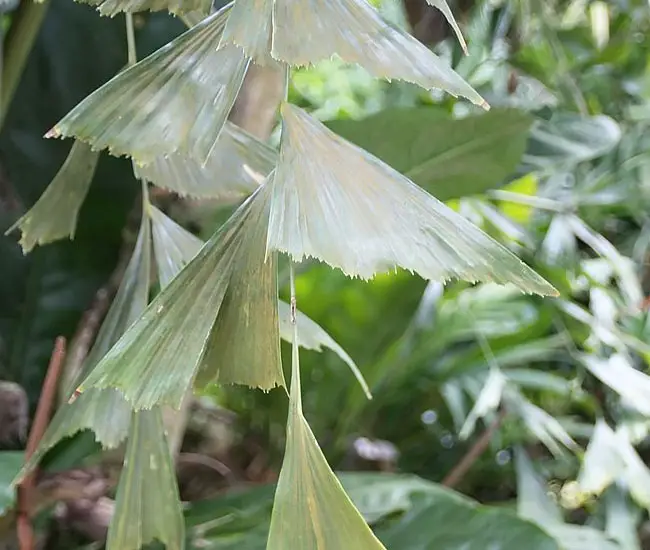
5. Entire Leaf
Also very rare is an entire (simple) leaf type which is composed of a single leaflet or a blade. It’s not divided and doesn’t have individual leaflets. A good example is Joey Palm and Miniature Fishtail Palm.
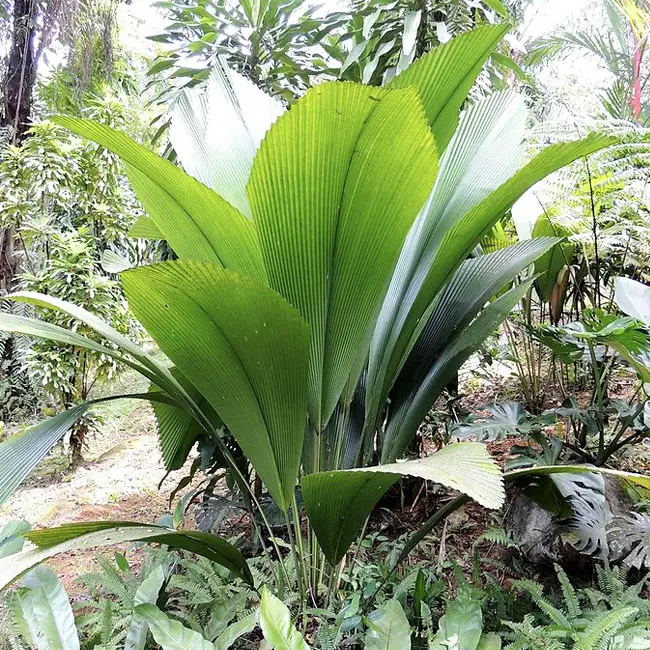
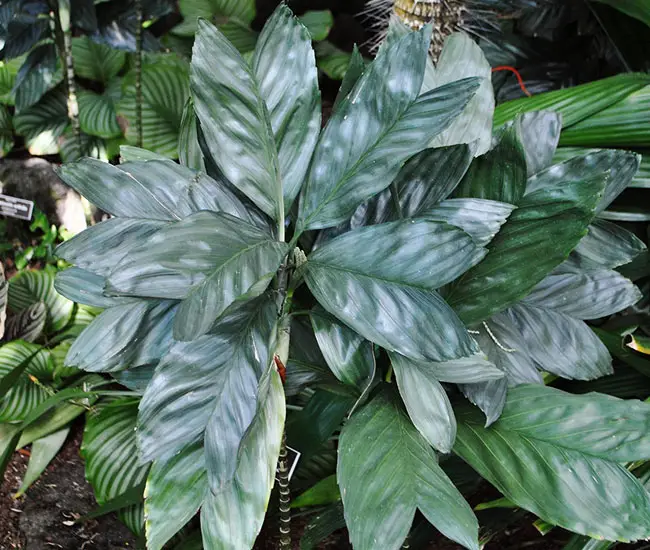
Palm Identification By Crownshaft
On some palms, leaf bases create a waxy and smooth structure called a crownshaft. The crownshaft can differ in color from the trunk, like in the case of a Lipstick Palm that has a striking red crownshaft or a King Palm that has a reddish purple crownshaft.
Palms with crownshaft tend to be “self-cleaning” meaning the dying leaves fall to the ground without pruning.
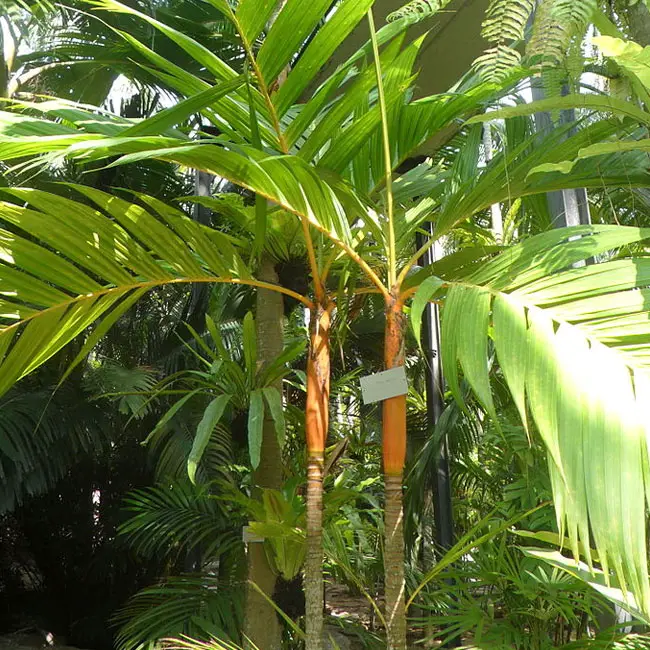
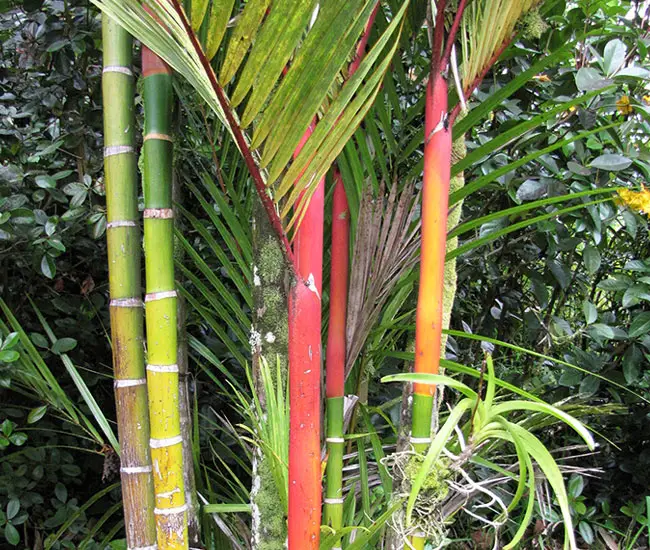
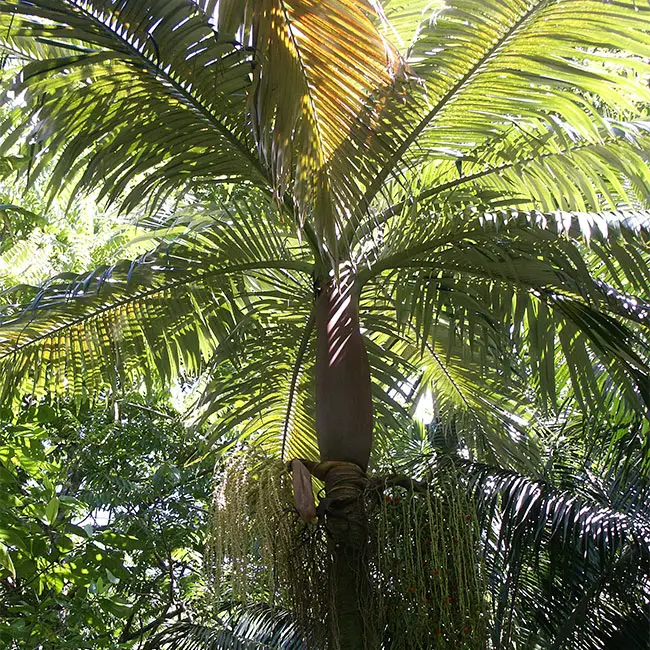
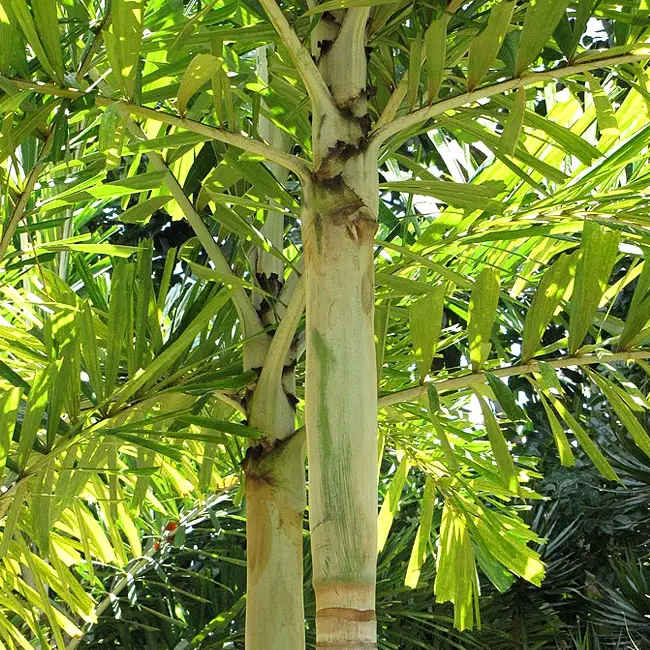
Palm Identification By Leaf Stems
Leaf stems can also be an identifying factor since they can also vary in color, size, and formation. Some can be armed with sharp teeth along the edges. Traveler’s Palm and Triangle Palm have very unique leaf formations at the base reminding me of the peacock tail.
Bismarck Palm has a very large dramatic crown with distinctive silver-green leaf stems and fronds. Taraw Palm, Bailey’s Copernicia Palm, and Date Palm all have stems with sharp spines along the margins.
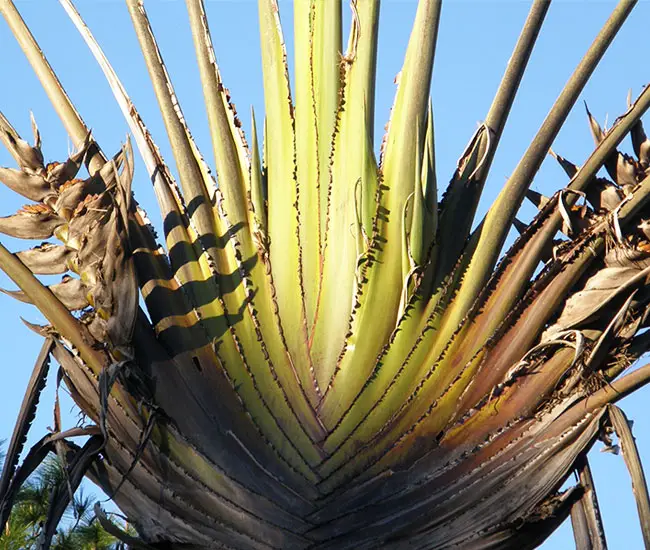
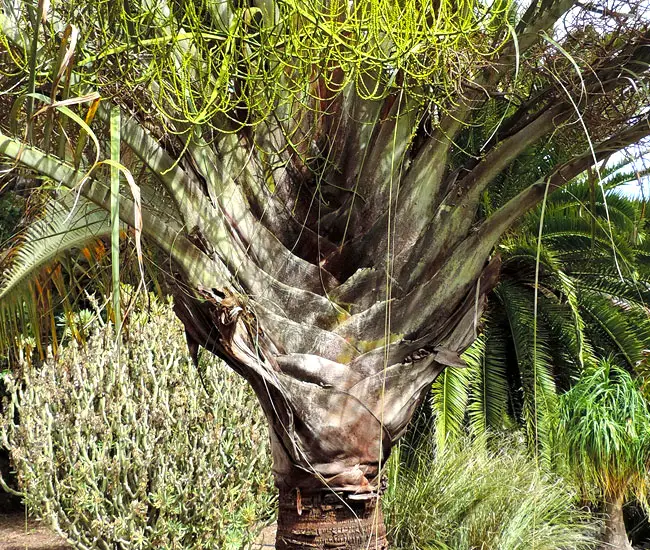
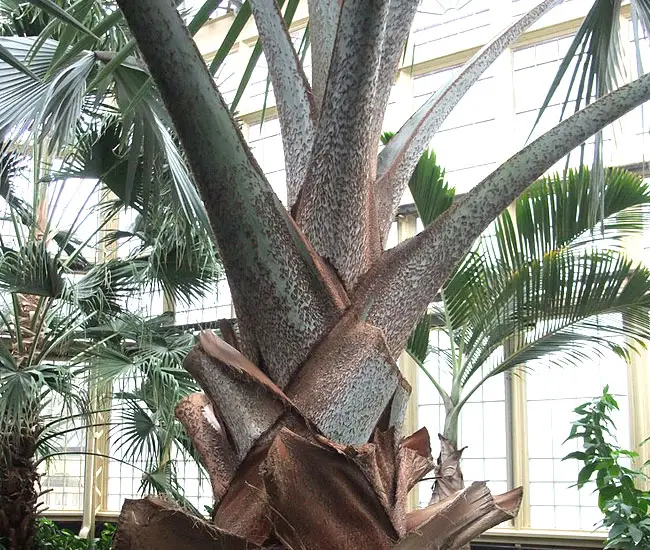
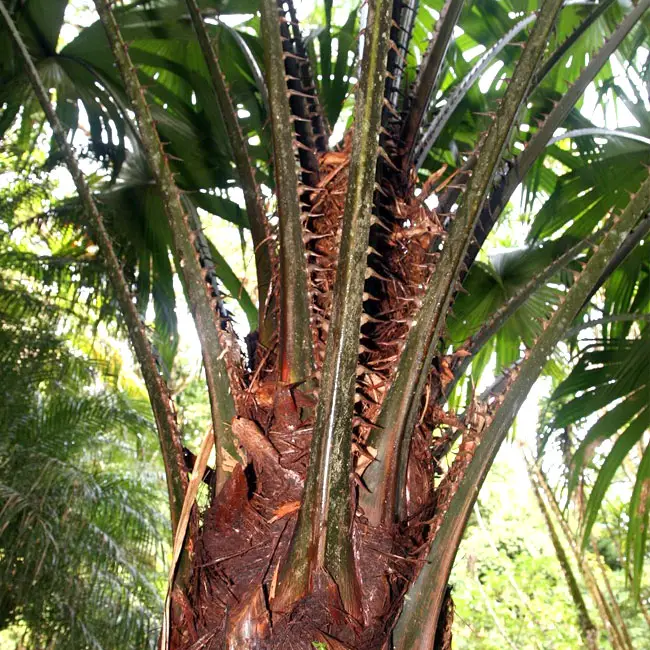
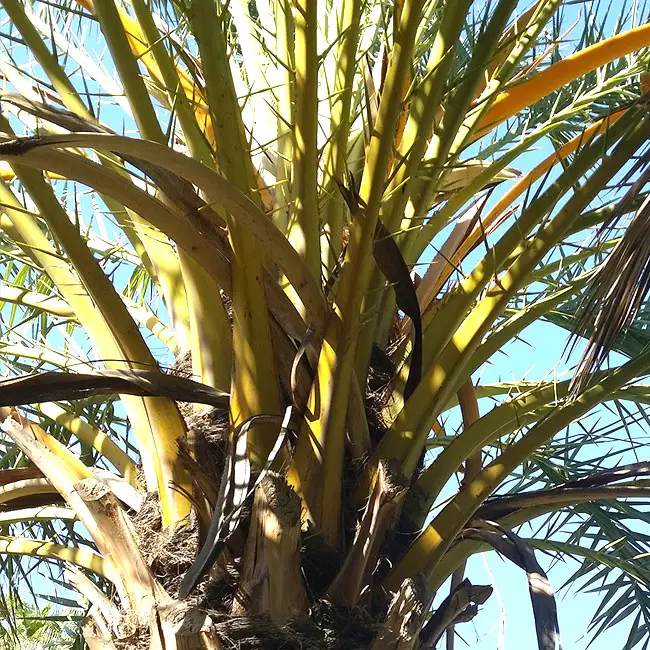
Palm Identification By Trunk Type
With over 2,500 palm species, you can find any trunk imaginable. Trunks differ in size, color, shape, number of trunks, texture, and other characteristics.
Let’s start with a number of trunks. Palms can have three different trunk types: solitary trunk, multi-trunk, or even no trunk.
Solitary Trunk Palms
Most palms have a single trunk. Some of the most popular palms with a single trunk are Foxtail Palm, Blue Hesper Palm, Princess Palm, and Bismarck Palm.
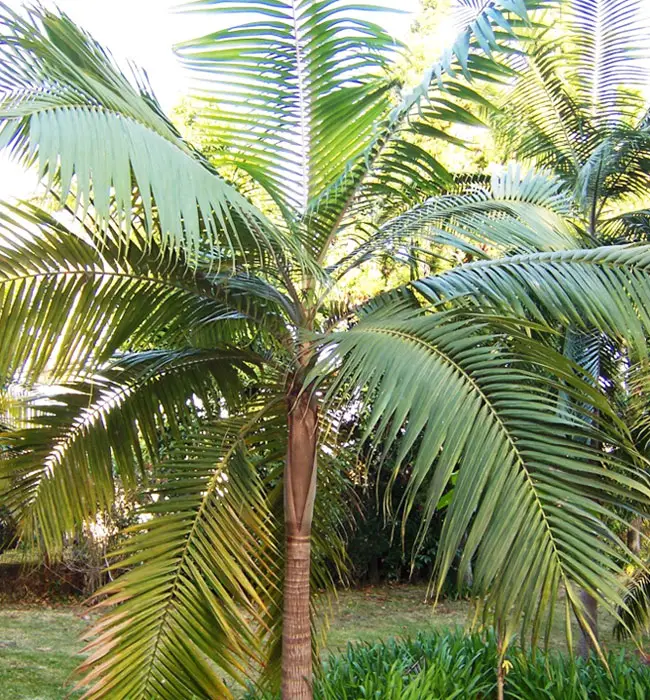
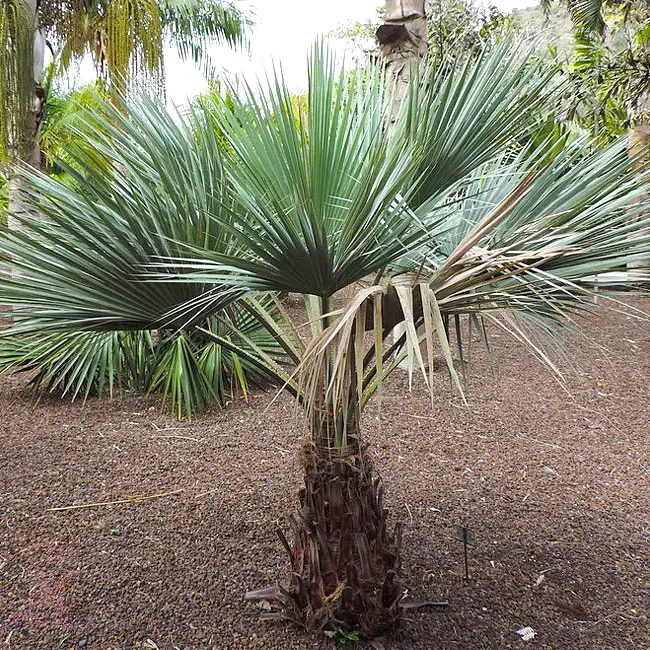
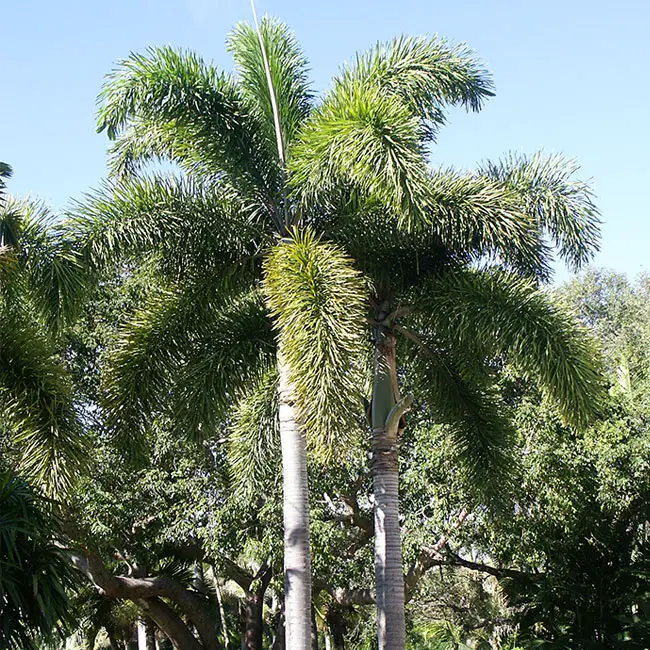
Multi-Trunk Palms
Usually, multi-trunk palms are shorter and grow slower. A good sample would be a Seashore Palm and Lady Palm. Both are slow-growing shrubby-looking plants. They are great for creating a privacy wall and can also be used for foundation plantings and in outdoor tubs and planters.
Acai Palm and Areca Palm’s growth rate is faster, but are both clustering palms with straight clean trunks.
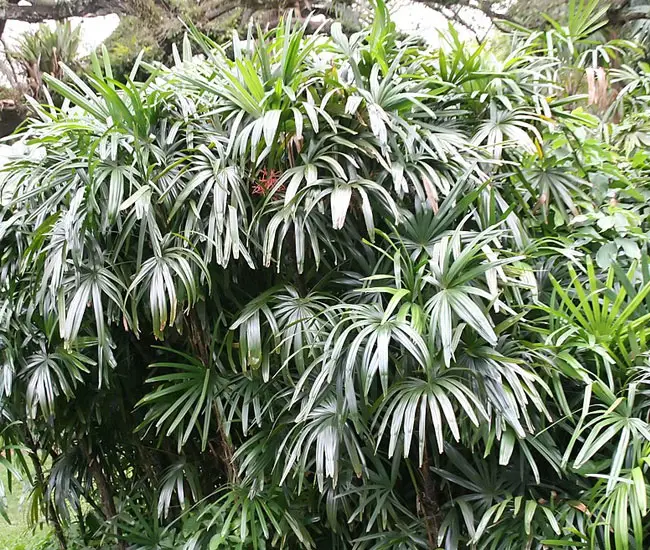
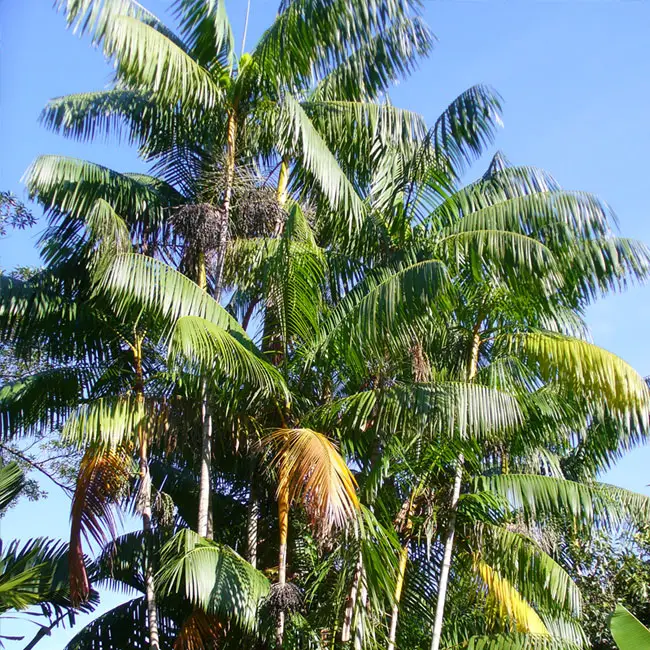
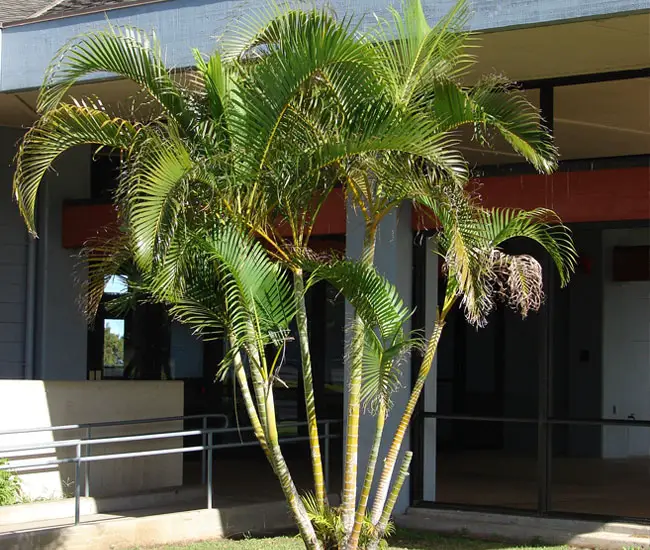
No Trunk Palms
Some palms develop a small trunk after many many years or have no trunk at all like Cat Palm and Needle Palm.
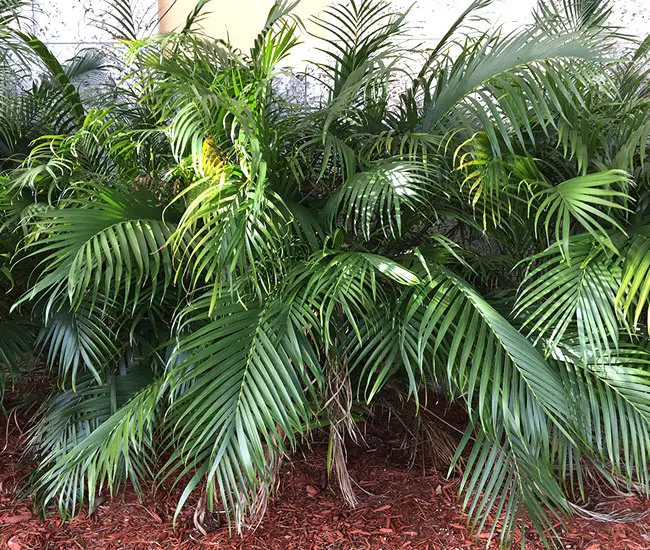
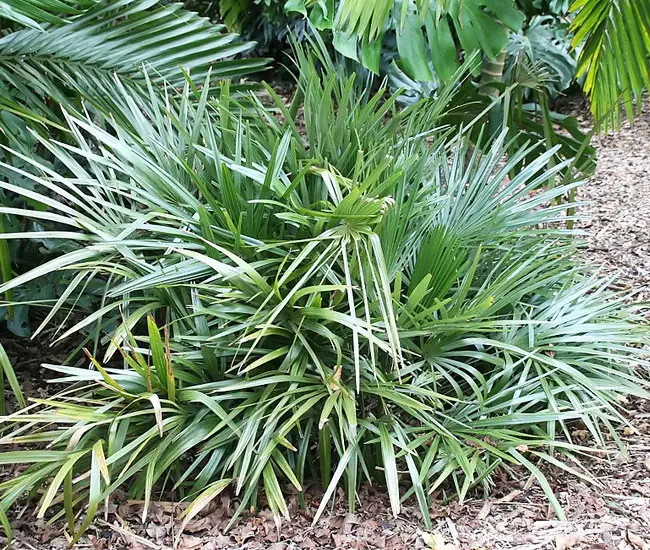
Palms With Self Cleaning Trunks
Furthermore, trunk surfaces also vary. Some have a smooth surface covered with scars from old leaves, others have a rough surface that is covered with old leaf bases in a crisscross pattern.
A good example of palms with “self-cleaning” trunks are the Carpentaria palm and Alexander Palm. A “self-cleaning” means the leaves fall off without pruning.
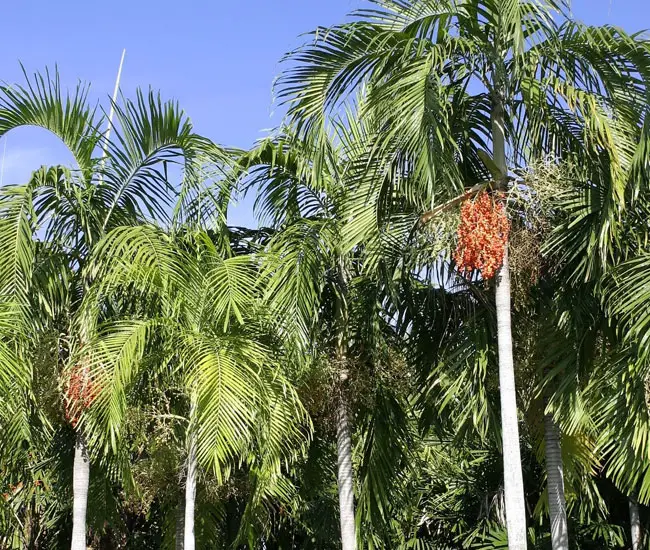
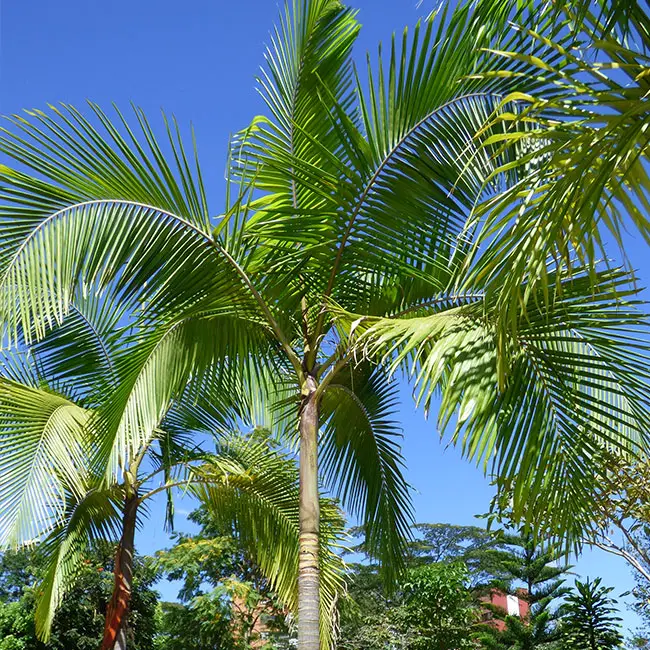
Old Leaf Bases Trunks
After leaves die, they drop off sometimes leaving a leaf base. Some of the palms with trunks covered with old leaf bases are Bailey Copernicia Palm, Cabbage Palm, Sylvester Date Palm, Caranday Palm, and Date Palm. These trunks look especially attractive when regularly pruned.
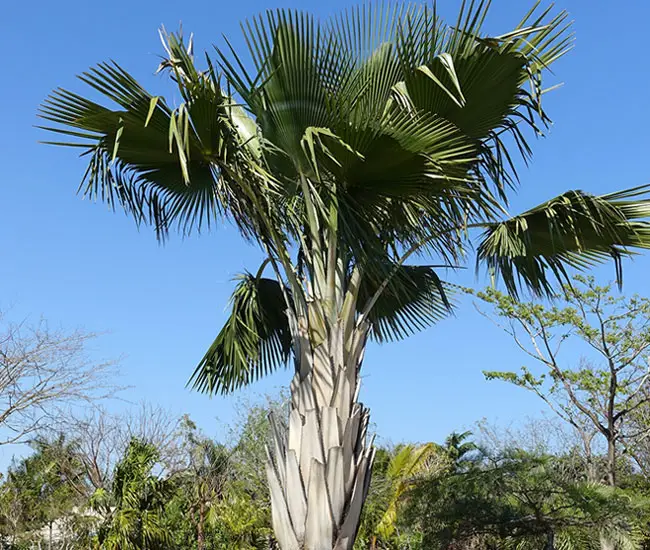
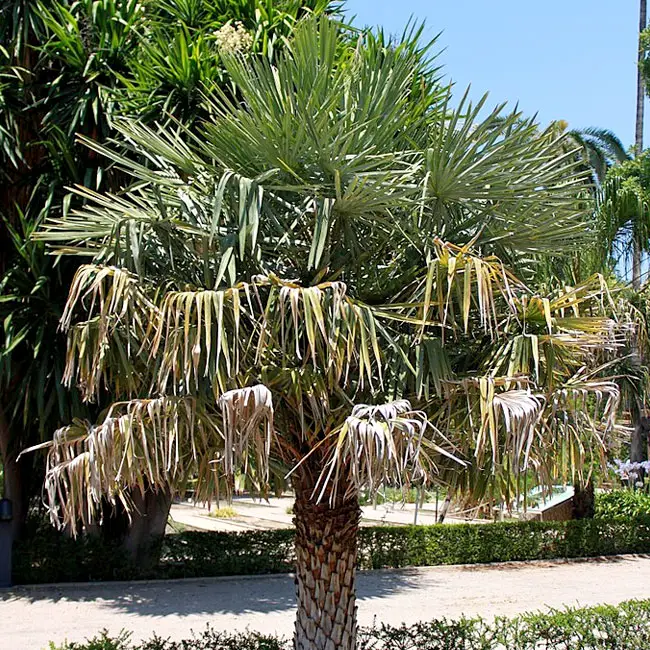
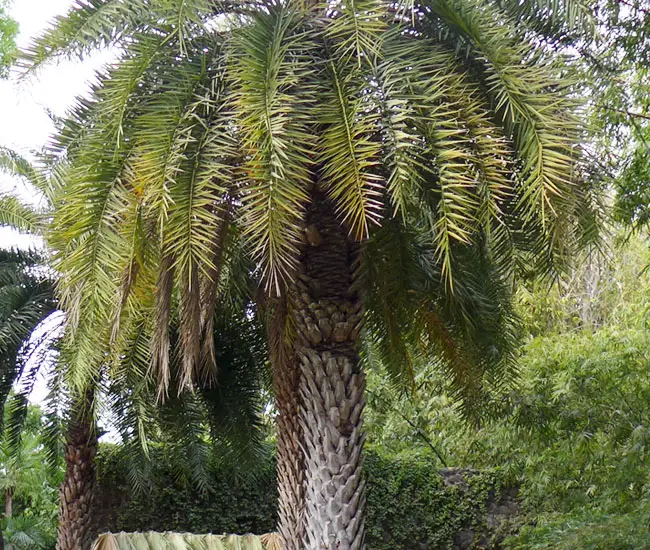
Different Trunk Texture
The texture of the trunks also varies. There are palms that have fiber covering, peg-like leaf bases, or even spines. Old Man Palm has a trunk covered with fibers, hence its common name.
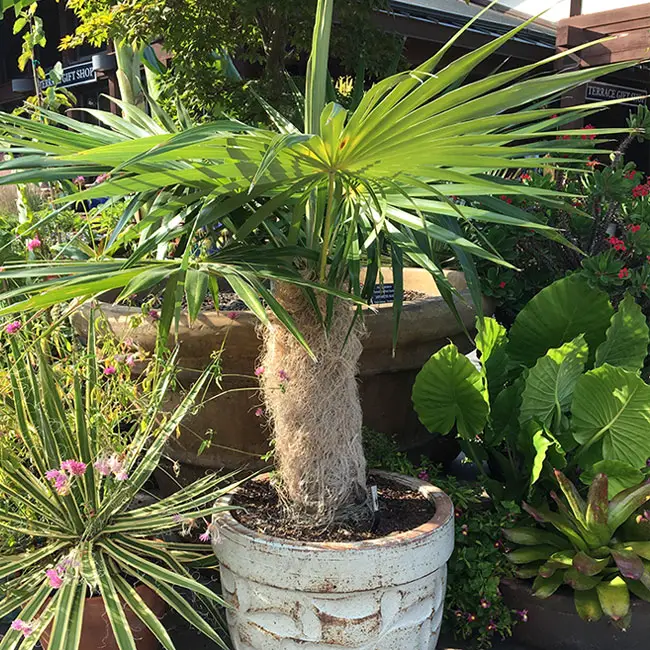
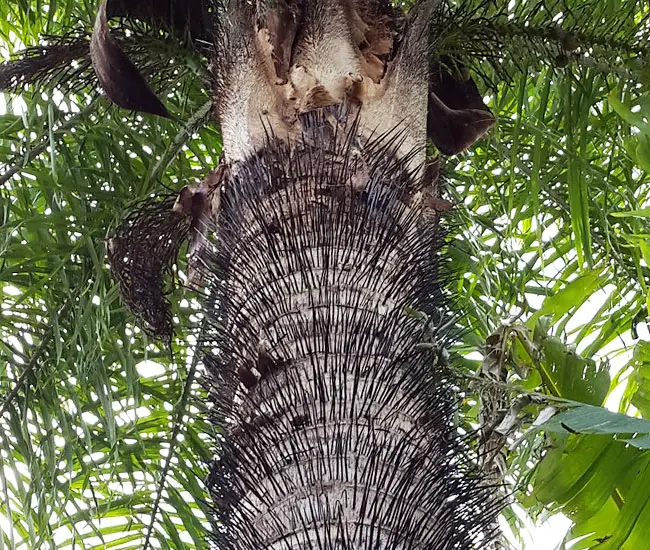
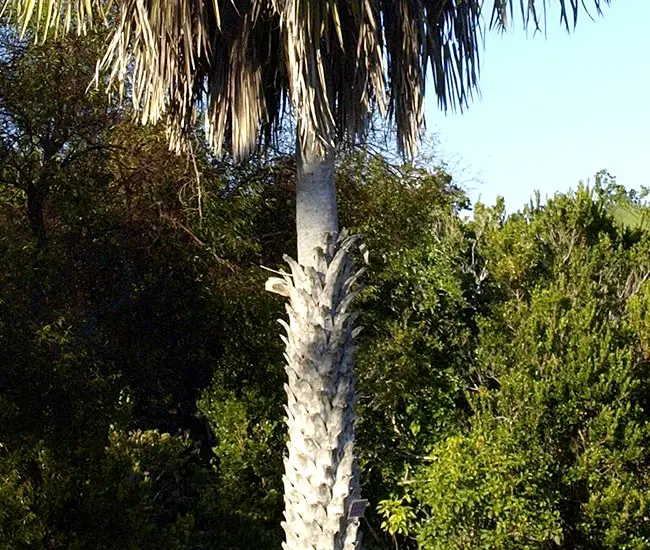
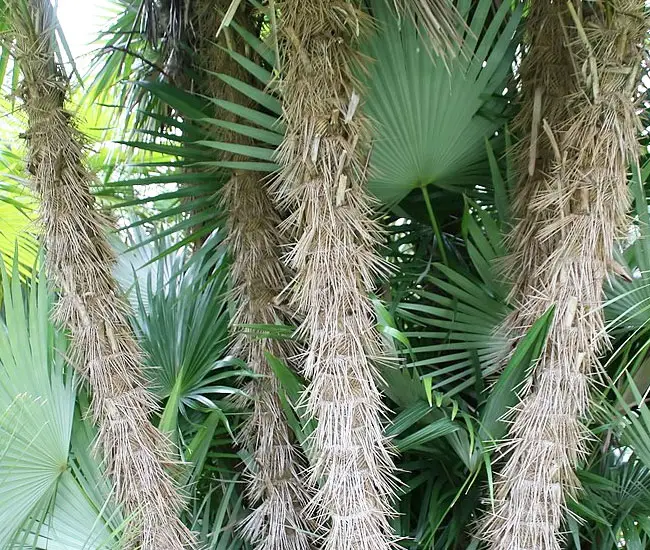
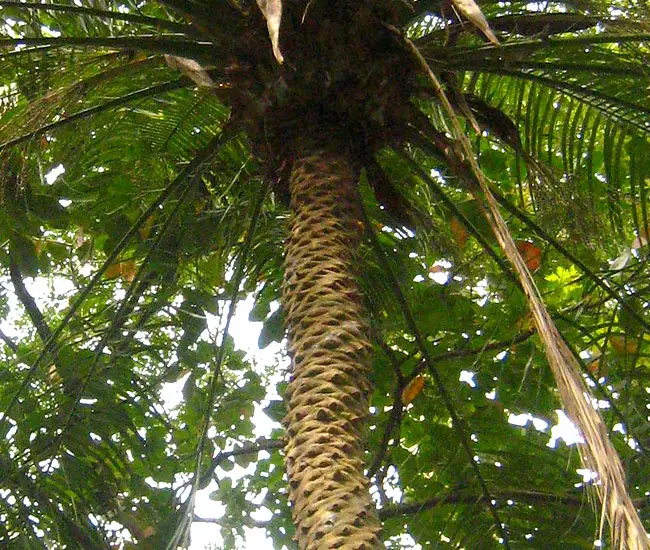
Swollen Trunks
The thickness of the trunk can also differ. Bottle Palm, for example, has a smooth bottle-shaped trunk that is wider at the bottom. The Cuban Belly Palm’s trunk is thin at the base and swollen in the middle, hence its common name.
Spindle Palm has a ridged trunk that is narrow at the base and widens in the middle resembling a spindle. Ponytail palm has a swollen base trunk that stores water making it highly drought tolerant.
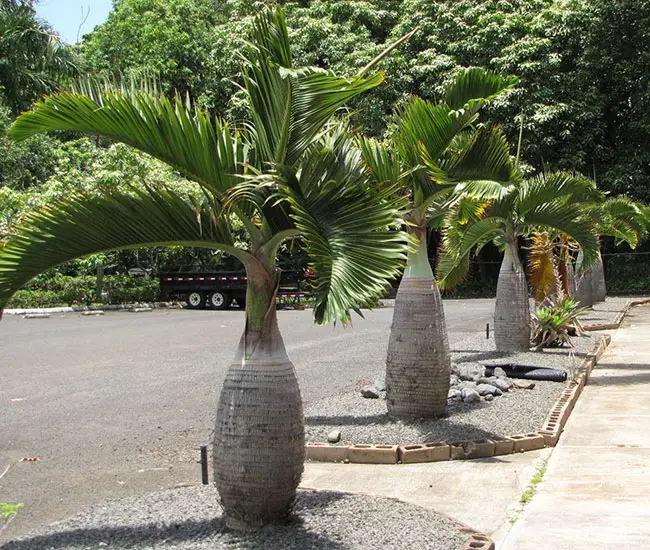
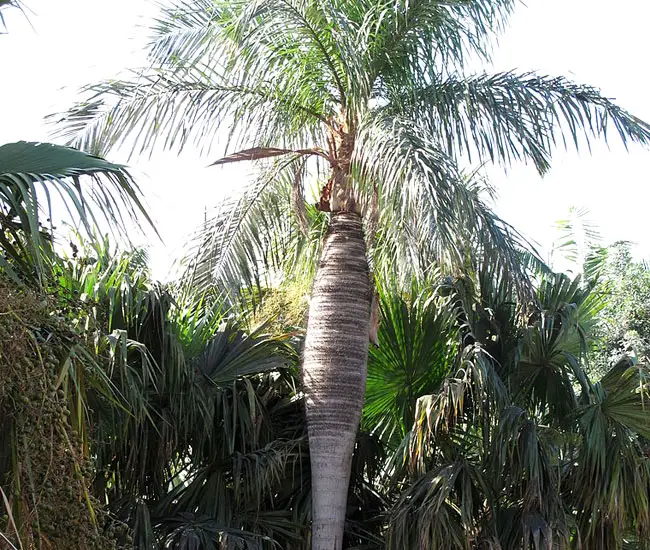
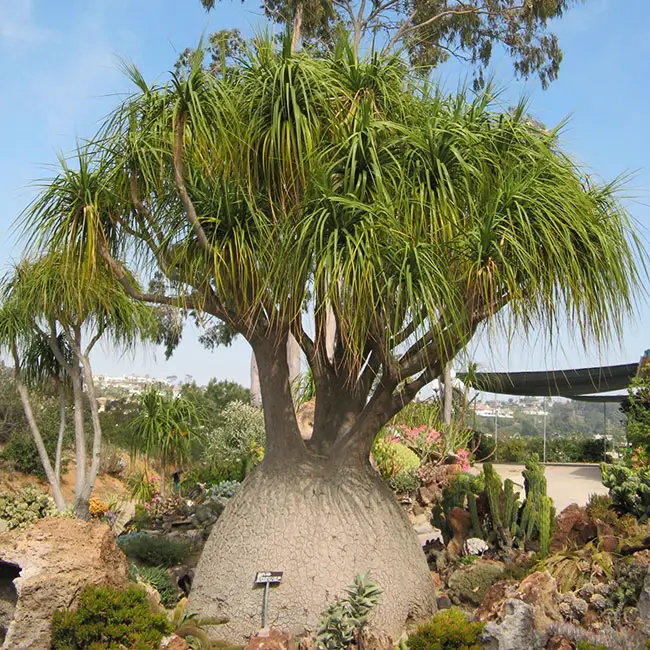
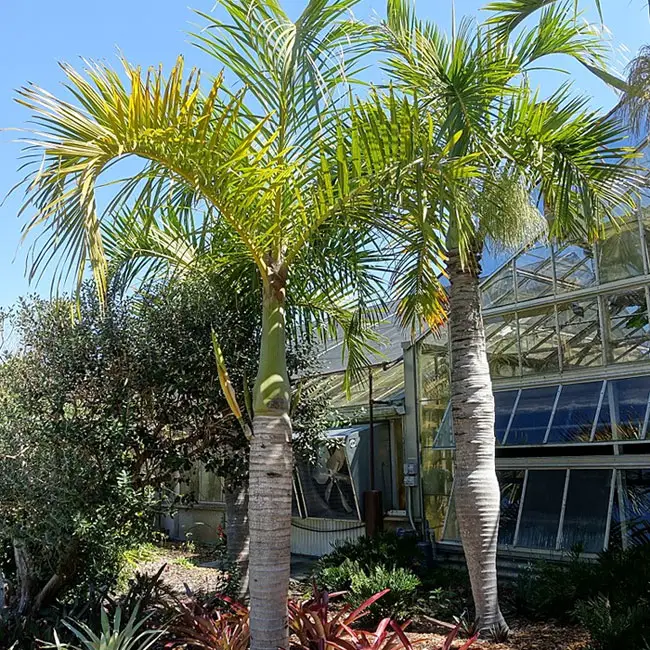
Palm Identification By Flowers and Fruits
Palms have very insignificant flowers that range in color from yellowish-green to light green. Generally, they grow in clusters on the long stems among the canopy or from below the crown shaft.
Flowers are usually followed by fruits that come as berries or nuts. Most of them are not edible except for some. Fruits can come in any color and is also a good identification characteristic.
Palms With Edible Fruits
The six palms below are the most popular palms with edible fruits. The Coconut Palm is one of the most recognizable palms around the world because of its fruits “coconuts”. Date Palm is widely known for its sweet fruits “dates” which have high nutritional value and are an important source of food in some countries.
Acai Palm produces black-purple tasty fruits that are packed full of antioxidants, amino acids, and essential omegas. Jelly Palm produces orange fruits that have a sweet pineapple/banana-like flavor and are great for making jelly.
Not as popular as other palms, Saw Palmetto Palm produces black-blue berries that are used to make medicine for kidney and prostate urinary problems. Guadalupe Palm produces small black fruits with a taste resembling dates.
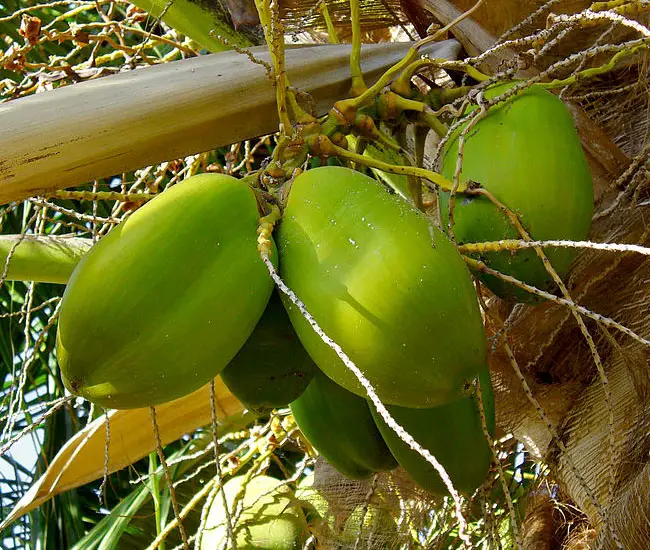
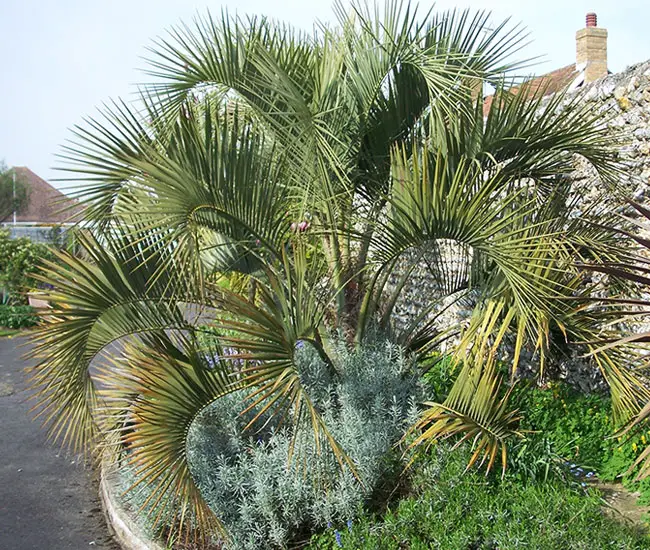
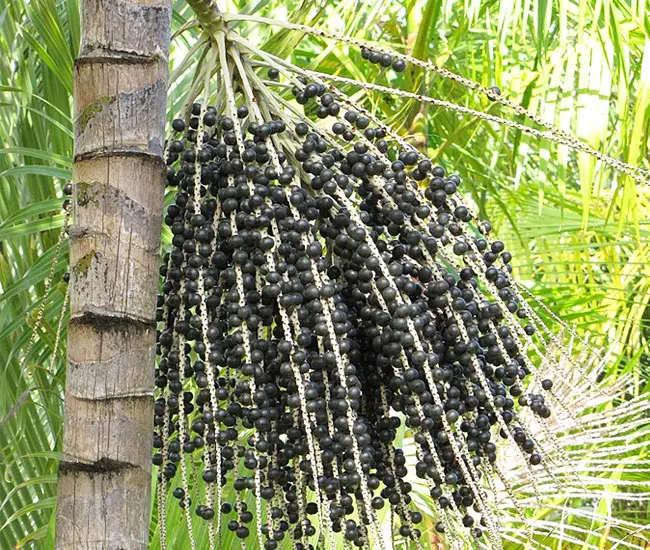
Palm Identification By Size
Palms come in different sizes. Some small palms, also called dwarf, can only reach 10 ft. Others can get very tall up to 100ft. While small palms usually are slow growing, tall palms grow at a faster rate.
The older the palm, the easier it is to identify. Young trees that are only a few months old have not developed their distinct features and all look the same.
Palms Characteristics
As you can see, each palm has its own features that make it unique. Here are some of the characteristics of the popular palms I’ve mentioned above:
Areca Palm (Chrysalidocarpus lutescens) – Multi-trunk palm that grows in clusters forming thick clumps. It has yellow-green feather-like leaves. Produces bright yellow flowers that are followed by yellow-orange berries. It can grow up to 20ft tall.
Bottle Palm (Hyophorbe lagenicaulis) – The main characteristic of this tree is its bottle-shaped single trunk. It has a bright green crownshaft with feather-like green leaves. Produces small white flowers that are followed by black berries. This is a dwarf palm that can only grow up to 15 feet tall.
Coconut Palm (Cocos nucifera) – This palm of course is most known for its delicious coconuts. It has a single smooth trunk and feather-like fronds. Produces sweet-scented yellow flowers that are followed by brown coconuts. Can grow up to 100 ft.
Date Palm (Phoenix dactylifera) – Single trunk covered with an ornamental diamond-shaped pattern of leaf scars. Feather-like dark green fronds. Produces white or yellow flowers that are followed by edible fruit, called ‘dates’. This is a large tree that can grow up to 50ft tall.
Queen Palm (Syagrus romanzoffiana) – Smooth single trunk, feather-like fronds. Produces creamy flowers that are followed by orange fruits. This is a very inexpensive tree that is widely used in tropical climates. It can quickly grow up to 40ft.
Old Man Palm (Coccothrinax crinita) – This is a rare and very expensive tree that is known for its fiber-covered trunk which looks like the beard of an old man. It has fan-shaped, stiff fronds. Produces yellow flowers that are followed by dark purple fruits. Grows up to 20ft tall.
Conclusion
With so many palm tree types, identifying a palm can be challenging. Start with the fronds which should be the easiest part. Next, look at the trunk and the stems. Then, look at the fruits it’s producing.
Finally, after you narrow down the parameters, look to see if you can find a similar tree around. Most likely, the palm you are trying to identify is common for your area.
Exotic palms like Old Man Palm are rare and expensive. Look at the palm pictures on our website or go to Google Images. On my site, I tried to post the most popular palm trees in the USA.
Related articles:
–Top 10 Most Popular Florida Palm Trees (with Pictures)
–Top 35 Types of Palm Trees (with Pictures)
–Expert Tips: How To Water Palm Trees The Right Way
–How To Plant A Palm Tree In 10 Easy Steps (with Pictures)

Dear Sir/Madam
Would it be possible to email some photos of our Palm in the hope that you can identify it?
Many thanks
Mark Jones
once again. I am wondering what kind of palm tree this is. a neighbor gave me a cutting of one of her palms. I love this palm and wanted the cutting. it has green front with dark or purpleish backing to the fronds
Fantastic website. Thank you so much! This will be really helpful to those who know nothing at all about how to garden in Florida.
Hey I’m Ashley! My husband and I live in Duluth Minnesota right now but are planning on moving down to Sarasota Florida in the summer of 2016, we are very excited. We plan on having roots down did I mention we are excited?!?!?! ☺ I was looking up palm trees and came a cross yours. Its very well explained and I will continue to learn more. I do have tree well its my moms but I think its mine. Well anyway its a plant but its looks like a miniature tiny palm tree maybe a foot half. I would like to send you a picture of it. I don’t know what kinda plant it is, its adorable though. Well thanks for your time!
Ashley
I need help identifying a palm tree with berries that’s growing in my backyard. I recently bought a house in this palm tree was already there. Is there a way I can send you a picture to help identify it?
I would like to buy these Palm trees, but I don’t know their name. Please help me to identify them.
1) About 10 feet tall, fan shaped leaves, cluster of blue berry fruit.
2) about 10 feet tall, fan shaped leaves, coconut fruit, yellow cluster flowers. Both Survive in Washington state (cold, rain, zone 9)
Thank you
hi I have two palms I think are canary palms I had from a ggod garden centre which said that’s what they are ..they have some sharp leaves on them and it grows from a single trunk ..is it a canary palm please and will they grow fruit ive got hem in tubs ..thankyou..Sharon…
I have a palm tree in my yard that nobody can identify and it’s been here for probably 30 years and it just started to seed and I wanted to see if somebody could identify it because nobody from the Palm Society in the past has been able to
I’m moving to srbring , Fl in a week and would like to know what palm trees I can grow there? I love queen,king,royal& foxtail & almost all tropical flowers, as Canna’s, bird of Paradise, and the many different banana palms. Thank you for any information you can provide and if the trees and plants I’ve mentioned can be grown in that part of Florida? And any suggestions.
looking to buy or grow a small palm tree and transport it to NH ( in Summer) and back to Florida in Winter.. thank you.
I recently moved to Florida. We gave a Palm in landscape and I have no idea what type, how big it gets, if previous owner planted in good location, how fast it grows, etc.
I am looking for tall palms for back yard and a relatively large taller palm as focal piece near front door in landscape. Can I send picture of tree and you give me suggestions?
Also any suggestions on palms would be greatly appreciated. We are 34613 zip. So not sure what trees are appropriate for this area. I like the tall trees with dark, stiff, type fronds..I also like the multi-trunk (2-3) in grandmother’s yard. And the type that has bottle type trunk.
Please help. If I know where to send pics for your help.
Thanks
On your Florida-Palm-trees.com site it would be nice if maybe you put another section on what palm species produce edible fruit/nuts/berries, and then maybe you can have another spin off of that page and have another on how to process them for at home consumption, How to tell when they are at peak ripeness, and maybe a little historical facts about each species like where it originates from, (country and culture/religious history of the species) and lastly what kind of recipes/dishes are favored by there native lands people, for a little bit of multicultural expiraments that may indulge the minds and taste buds of the Americas and beyond! Just a friendly suggestion :) I look forward to hopefully hearing from you and coversing about palms!
Me again! Just forget to say this in last post, I live in a zone 3/4 area, (Northern Vermont) the only palms I can grow are first-of-all indoors or in greenhouse/conservatory which I don’t have the latter two, wish I did but I have a pony tailed Palm and am thinking about buying from Logee’s greenhouse and nursery a dwarf date palm that I never new existed so really excited that it can fit in my home aswell as produce edible fruit! I love tropical palms/plants/edible exotic fruit-bearing plants but am restricted right now to living in this freezer! Maybe, since the earth is getting warmer the zones will change up north in my life time and I’ll get to grow something outside that’s more exotic like the cool palms you produce and provide. This is probably just a fantasy, hopefully we make change to the environment before it gets this bad!!
Roughly how long (in years) does it take for a ponytail Palm that’s 6″ tall from soil level to top of greenery to grow to about ceiling height (mine is 8′ tall) ish?
Oops my ponytail Palm is 6 inches tall and ceiling is 8 feet tall!
I live part-time in Puerto Vallarta, Mexico and my hobby is identifying trees. I have been having a hard time identifying some palm trees and your article came up in my search. I found it very helpful. Can you give me some clues to distinguish among King palms and distinguish them from Royal, Fox tail and Queen. They all have crown shafts and look alike to me at first glance. I think I have Royals down because of the swelling in middle of the trunk. Some ‘keys’ and internet sources would be helpful.
Al Rouyer
I visited Fort Myers, FL recently, and found some beautiful rope/braid-like “pods(?)” under a tree. They average about 10-12 inches long. Most are brown, but some were still green. I have pictures of them, but I didn’t think to get a picture of the tree itself. The closest thing I’ve been able to find on the internet is the Fishtail Palm, however, I don’t think that’s it. Does anyone know what kind of tree it could be?
How can I distinguish between a Phoenix dactylifera and Phoenix canariensis? They look exactly alike, and I’m even more confused when it’s a male date palm because then it’s identical to the canary island palm.
Thanks
I can’t figure out what is wrong with my palm tree. Can I send you a picture.
Thanks
I have searched and searched but cannot identify my palm. I have taken some pictures I can send your way if you respond.
Thanks
I was given a small palm tree 3 years ago. It had a single trunk and 3 leaves. About 3 ft tall. It now has 8 trunks and is about 12 ft tall. It has bluish fronds like my Bismarkia. It is throwing long sprays of oddly shaped seeds. I think that it must be some sort of branching palm, but doesn’t seem to fit into all of the criteria for any one tree. I live in BCS Mexico, so we have lots of heat and sun, but are actually a desert environment. I can send photos if you think you can help me identify this lovely palm, thank you
Marilyn
I have a Mexican palm that was burned really bad this winter. There is one green leaf left coming out of the middle . It has stopped putting out leafs all together. It is about 20 feet tall. I don’t want to lose this palm! Any suggestions please?
I have both Royal and Queen palms growing in my yard.
I now have some juvenile palms that are a couple of feet high.
Maybe all the ones I have growing wild are queen palms.
This gets easy when they are 10 feet tall, but when just a bunch of fronds sprouting a few feet out of the earth, I can’t tell.
Is there any way to distinguish between juvenile Royal Palms compared to queen palms?
I don’t want any more queen palms, but do want to encourage any Royals.
I am trying to identify a palm in zone 9b, Lakeland,FL. Since the last freeze we had this palm, which I saw in someone’s yard, did wonderful. Not a dead frond on it. I would like to send a picture but can’t figure out how to attach.